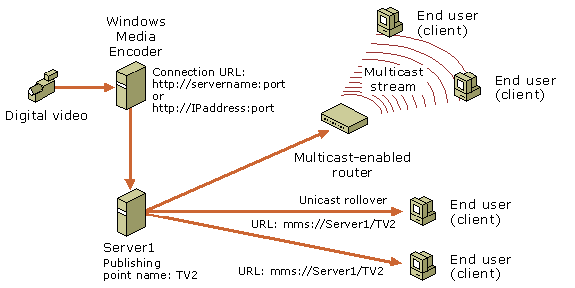Delivering content as a multicast stream
Multicast streaming is a one-to-many relationship between a Windows Media server and the clients receiving the stream. With a multicast stream, the server streams to a multicast IP address on the network, and clients receive the stream by subscribing to the IP address. All clients receive the same stream. Because there is only one stream from the server regardless of the number of clients receiving the stream, a multicast stream requires the same amount of bandwidth as a single unicast stream containing the same content. Using a multicast stream preserves network bandwidth and can be useful for low bandwidth local area networks.
You can deliver content as a multicast stream only from a broadcast publishing point. In addition, your network routers must be multicast-enabled, meaning that they can transmit class D IP addresses. If your network routers are not multicast-enabled, you can still deliver content as a multicast stream over the local segment of your local area network.
The following figure shows an example of content being distributed from an encoder as a multicast stream by using a broadcast publishing point.

These steps describe one way you can multicast live content from an encoder, as shown in the previous figure.
- Send the live images from a digital video camera to a video capture card on a computer running Windows Media Encoder. The images are encoded into Windows Media Format, and then streamed to the server using HTTP.
- On the Windows Media server called Server1, use the Add Publishing Point Wizard to add a broadcast publishing point that sources from the encoder. As part of the wizard. you may choose to allow . Unicast rollover ensures that players that cannot access the multicast stream can still receive the content by switching to an available unicast stream. For example, a player may be unable to access the multicast stream if the network routers are not multicast-enabled, or if the player is beyond the time-to-live (TTL) radius of the multicast stream.
- Use the Multicast Announcement Wizard to create an announcement to provide users with the URL to the content. The wizard can create a multicast information file (with an .nsc file name extension), an file (with an .asx file name extension), the code necessary to embed an announcement within a Web page, or any combination of those three options.
 Note
Note
- Multicast streaming and the WMS Multicast Data Writer plug-in are available only if Windows Media Services 9 Series is running on the following editions of the operating system: Windows Server 2003, Enterprise Edition and Windows Server 2003, Datacenter Edition. If you are running Windows Server 2003, Standard Edition, these features are not supported.
Related topics
© 2000-2003 Microsoft Corporation. All rights reserved.



 Note
Note